COVID-19 has recently brought Nebraska onto the national and international stage, and the attention is not all positive. To begin, the state’s strong economy has attracted a growing number of immigrants to both rural and urban areas. Criticisms have been raised around the lack of access to adequate protections for these immigrants who are filling roles of essential workers and being exposed to the virus on the job. This has led to a disproportionate amount of ethnic and racial minorities contracting COVID-19. If the state wants to keep our towns strong, healthy, and growing, we will need to include, support, and consult many of Nebraska’s most vulnerable essential workers when creating change that protects everybody.
Today, our state is facing the crisis of a century, and some of our most essential workers have the greatest risk. Whether we are laborers, neighbors, family members, or friends of those employed in meat processing facilities, we need to listen to their stories, recognize immediacy, and provide support. We should help not only because immigrant workers are the backbone of Nebraska’s growing communities in both rural and urban areas, but due to the immediate and dire situation they, our neighbors, friends, and family face.
In the U.S. food processing industry, 49.1 percent of jobs are occupied by immigrants. Those foreign born account for 21.6 percent of all food sector workers, which makes up 3.8 million workers exposed to COVID-19. These numbers are further exemplified, as “Among 9,919 (61 percent) cases in 21 states with reported race/ethnicity, 87 percent occurred among racial and ethnic minority workers.” More locally, since Oct. 2, Nebraska’s meatpacking plants accounted for 1 in 5 of the state’s confirmed cases at more than 5,000 people infected and 21 deaths. Each one of these people were placed at risk for economic incentives.
Since late October, national estimates of COVID-19 among meatpacking workers have reached over 50,000 and at least 255 have lost their lives. According to more conservative estimates, the Centers for Disease Control and Prevention (CDC) outlines among the 23 states reporting COVID-19 (many states are not reporting) in the meat and poultry processing sector, 16,233 cases and 239 fatalities were reported. Nebraska is leading the country with more than 5,000 confirmed COVID-19 cases among meatpacking facility plant workers and 21 deaths. Erik Omar, executive director of Immigrant Legal Center, writes, “Sixty-six percent of Nebraska’s meat processing workers are immigrants,
many of whom are unjustly denied access to unemployment benefits and not allowed to receive stimulus money through the most recent CARES Act.” Indeed, immigrants are essential workers and community members who pay their fair share of state and federal taxes. Protecting and supporting the individuals most at risk secures each of our families’, friends’, and neighbors’ health in this uncertain time. One area increasingly at risk is our rural communities.
For more than 100 years, Nebraskans have developed and demonstrated a keen ability to grow, adapt, work hard, listen, and build communities that the nation can look to as an example of resilience and inclusion. However, if you fast forward just a few months from early outbreaks, the situation became more serious, as state politicians insisted meatpacking plants and other manufacturing centers stay open without reporting COVID-19 cases. By Dec. 10, there were a total of 145,836 COVID-19 cases across Nebraska and 1,348 deaths. Whether you believe these services should or should not be open, COVID-19 is disproportionately impacting Nebraskans of color. As Nebraskans, our responsibility is to address and improve the circumstances that immigrants are forced to operate within.
Throughout the COVID-19 pandemic, we are reminded that 19.3 percent of the population lives in rural America, and they live on 97 percent of the country’s land. Where one lives should not dictate access to safe employment, good health care, and a high quality standard of living. Yet, COVID-19 cases in rural America are increasing and these communities are no longer as “off the grid” as we’d like to think. Nationally, there are 15.8 million cases of COVID-19 and 294,362 deaths as of Dec. 10. Regardless of how you cut the data, rural areas share 2,239,095 of reported COVID-19 cases, which accounts for 38,172 deaths as of Dec. 5. Not being exempt, rural and urban people alike are called to come together and find tangible solutions to this expanding problem.


